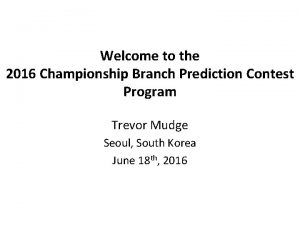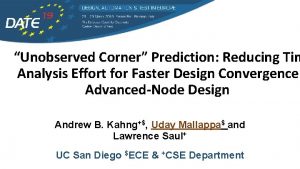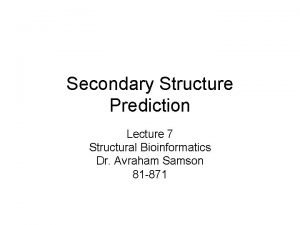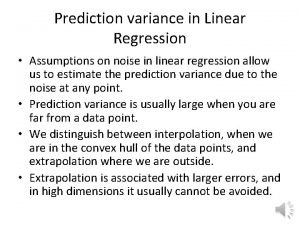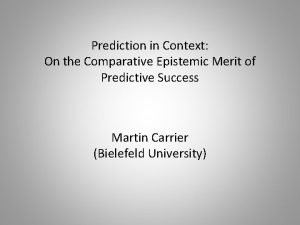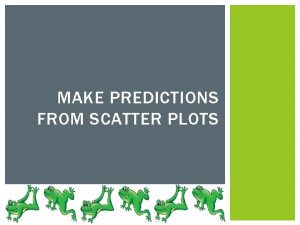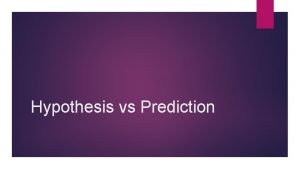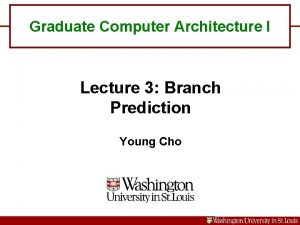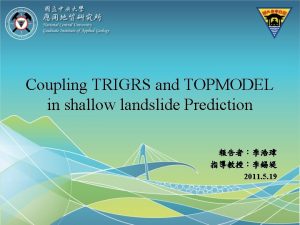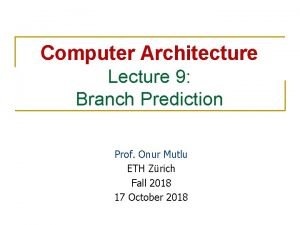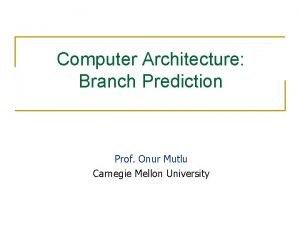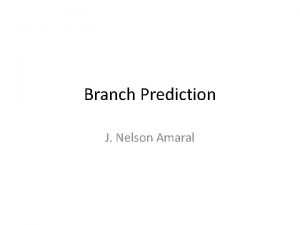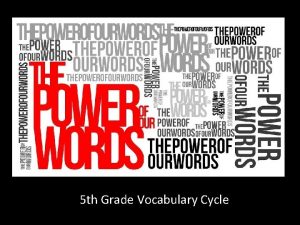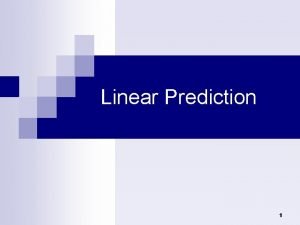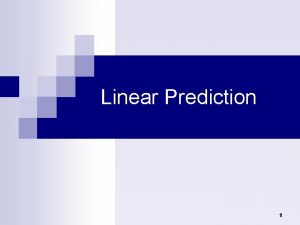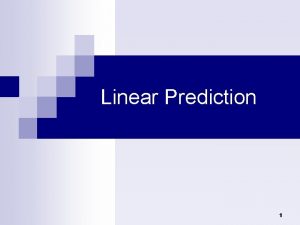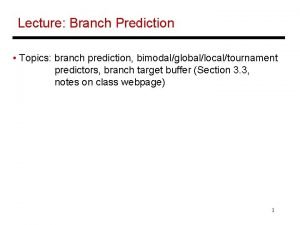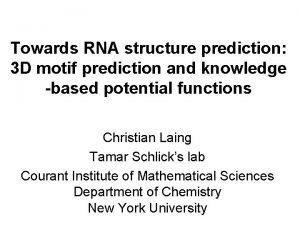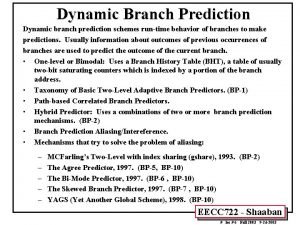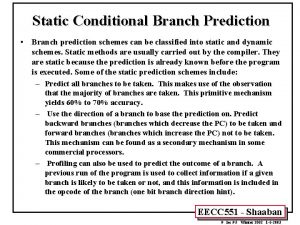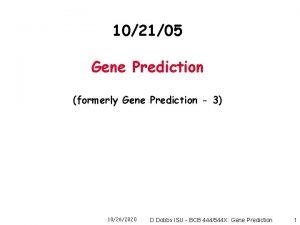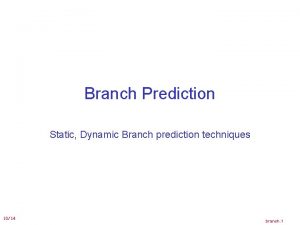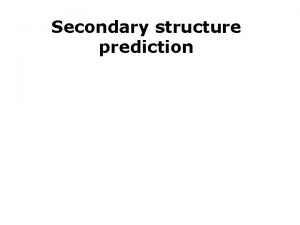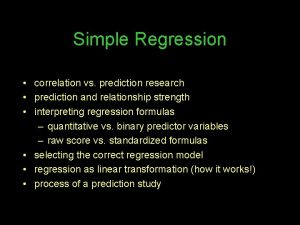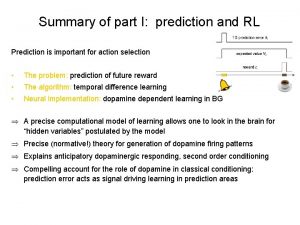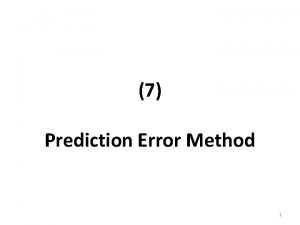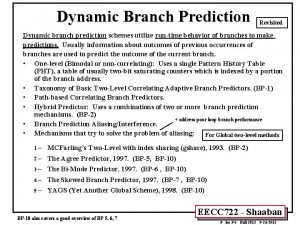An Introduction to Microarchtectural Prediction Why Prediction In


























- Slides: 26

An Introduction to Microarchtectural Prediction

Why Prediction? • In the beginning, computation proceeded one step at a time • We discovered parallelism, in particular instruction-level parallelism • Some instructions can execute at the same time as others without violating program semantics • But some dependences remain, giving rise to control and data hazards • Naïve solution to hazards: wait for them to resolve. Can negate the benefit of exploiting parallelism • Some operations take longer than others • E. g. accessing memory, accessing the network, executing FP instructions • Caching can mitigate the latency, as long as the caches contain data that will be accessed in the future • So we try to predict the future: • What will be the result of that instruction? • What will be the most profitable data to keep or bring into the cache?

Pipeline Hazards • A simple model to understand why we predict: pipelining • Simple model of pipelining, IF ID EX MM WB, is a useful lie • A value is needed in cycle t, but produced at time t+Δ • For example, a control hazard: • We fetch a branch at cycle 0, at stage IF of the pipeline At cycle 1 we need to fetch another instruction • But the branch might not resolve until after EX • So we stall for two cycles? • In real pipelines the delay might be 15 or more cycles • For example, a data hazard • We attempt to read a load at cycle 4, at stage MM in the pipeline • A subsequent instruction needs the load value at cycle 5, at stage EX • But the load missed in the cache. Stall for how many cycles? 4? 200+?

Control Hazards • Branches • What is the outcome of the branch? Where should we fetch next? • • Conditional branch – taken or not taken, fetch from target only if taken Indirect branch or call – target from register or memory Return – target from machine stack Unconditional branch or call – target from offset in opcode • Some ISAs (e. g. ARMv 7) also have conditional indirects, conditional calls, conditional returns • We must predict whether the branch is taken or not taken, and if it’s taken, we must predict the target • Neither of these things is readily available when the instruction is fetched

Branch Direction Prediction • First important case of microarchitectural prediction • Predict whether a conditional branch is taken or not • Jim Smith first documented ideas for conditional branch prediction in https: //dl. acm. org/doi/10. 5555/800052. 801871 A study of branch prediction strategies in ISCA 1981. I was in 6 th grade. You weren’t born yet. Raiders of the Lost Ark was the #1 movie. • Yeh and Patt documented significant advancement in a line of papers beginning with https: //dl. acm. org/doi/10. 1145/123465. 123475 Twolevel adaptive training branch prediction in MICRO 1991. Home Alone was the #1 movie.

Smith’s paper

Two-level adaptive branch prediction u Most predictors based on 2 -level adaptive branch prediction [Yeh & Patt ’ 91] u u u GAs – a common type of predictor Branch outcomes shifted into history register, 1=taken, 0=not taken History bits and address bits combine to index a pattern history table (PHT) of 2 -bit saturating counters Prediction is high bit of counter Counter is incremented if branch is taken, decremented if branch is not taken Branches tend to be highly biased 7

Branch Direction Prediction continued • Scott Mc. Farling documented two more significant advances, gshare and tournament-style hybrid branch predictors, in https: //www. hpl. hp. com/techreports/Compaq-DEC/WRL-TN-36. pdf, Combining Branch Predictors, a DEC technical report in 1993. Jurassic Park was the #1 movie. • The work of Patt’s group along with Mc. Farling’s contributions inspired a lot of follow-up research using correlation and various kinds of hybrid predictors • A lot of papers published in the 1990 s. Too many. Some good ones: • analysis via compression: https: //dl. acm. org/doi/10. 1145/248209. 237171 (ASPLOS 1996) • This paper seems boring but becomes very important later! • • gskew: https: //dl. acm. org/doi/10. 1145/384286. 264211 (ISCA 1997) - funny hash functions Agree: https: //dl. acm. org/doi/10. 1145/384286. 264210 (ISCA 1997) - avoid aliasing via bias Bi-Mode: https: //ieeexplore. ieee. org/document/645792 (MICRO 1997) - avoid aliasing again YAGS: https: //ieeexplore. ieee. org/abstract/document/742770 (MICRO 1998) - tagging

Mc. Farling’s predictors tournament gshare Figures from H&P architecture textbook

Branch Direction Prediction continued • Calvin Lin and I published https: //ieeexplore. ieee. org/document/903263 Dynamic Branch Prediction with Perceptrons, at HPCA 2001. Had a big impact and motivated more research (Harry Potter was the movie) • I wrote several more papers on neural branch prediction • https: //ieeexplore. ieee. org/stamp. jsp? arnumber=1253199 Fast Path-Based Neural Branch Prediction • https: //ieeexplore. ieee. org/abstract/document/1431572 Piecewise Linear Branch Prediction • Etc. , look it up • Other key insights from this period: • https: //dl. acm. org/doi/10. 1145/1089008. 1089011 Hashed Perceptron, TACO 2005 • https: //dl. acm. org/doi/abs/10. 1145/1080695. 1070003 O-GEHL, ISCA 2005 • https: //www. jilp. org/vol 9/v 9 paper 6. pdf L-TAGE, JILP 2007

Perceptron Branch Predictor • Neural learning for predicting branches is a natural fit • Input is history of branches – taken/not taken • Outut is binary: predict taken or not taken • First idea: perceptron predictor [Jimenez&Lin 2001] • Neural-inspired branch predictors the most accurate in the literature • Dynamically train perceptrons to predict conditional branches • Addressing problems with perceptron and other predictors • Latency – ahead pipelining [HPCA 2003, MICRO 2003, TOCS 2005, etc. ] • Linear inseparability – piecewise linear prediction [ISCA 2005, JILP 2005] • Power – analog neural predictor [MICRO 2008, IEEE Micro“Top Picks” 2009] 11

Input and Output of the Perceptron • The inputs to the perceptron are branch outcome histories • Just like in 2 -level adaptive branch prediction • Can be global or local (per-branch) or both (alloyed) • Conceptually, branch outcomes are represented as • +1, for taken • -1, for not taken • The output of the perceptron is • Non-negative, if the branch is predicted taken • Negative, if the branch is predicted not taken • Ideally, each static branch is allocated its own perceptron 12

Branch-Predicting Neuron • • • Inputs (x’s) are from branch outcome history – taken or not taken n + 1 small integer weights (w’s) learned by on-line training Output (y) is dot product of x’s and w’s; predict taken if y ≥ 0 Training finds correlations between history and outcome Dot-product computation has high latency and power 13

Input and Output of the Perceptron • The inputs to the perceptron are branch outcome histories • Just like in 2 -level adaptive branch prediction • Can be global or local (per-branch) or both (alloyed) • Conceptually, branch outcomes are represented as • +1, for taken • -1, for not taken • The output of the perceptron is • Non-negative, if the branch is predicted taken • Negative, if the branch is predicted not taken • Ideally, each static branch is allocated its own perceptron 14

Branch-Predicting Perceptron • Inputs (x’s) are from branch history and are -1 or +1 • n + 1 small integer weights (w’s) learned by on-line training • Output (y) is dot product of x’s and w’s; predict taken if y ≥ 0 • Training finds correlations between history and outcome 15

Training Algorithm 16

What Do The Weights Mean? • The bias weight, w 0: • Proportional to the probability that the branch is taken • Doesn’t take into account other branches; just like a Smith predictor • The correlating weights, w 1 through wn: • wi is proportional to the probability that the predicted branch agrees with the ith branch in the history • The dot product of the w’s and x’s • wi × xi is proportional to the probability that the predicted branch is taken based on the correlation between this branch and the ith branch • Sum takes into account all estimated probabilities • What’s θ? • Keeps from overtraining; adapt quickly to changing behavior 17

Organization of the Perceptron Predictor • Keeps a table of m perceptron weights vectors • Table is indexed by branch address modulo m [Jiménez & Lin, HPCA 2001] 18

Mathematical Intuition A perceptron defines a hyperplane in n+1 -dimensional space: For instance, in 2 D space we have: This is the equation of a line, the same as 19

Mathematical Intuition continued In 3 D space, we have Or you can think of it as i. e. the equation of a plane in 3 D space This hyperplane forms a decision surface separating predicted taken from predicted not taken histories. This surface intersects the feature space. Is it a linear surface, e. g. a line in 2 D, a plane in 3 D, a cube in 4 D, etc. 20

Hashed Perceptron u Introduced by Tarjan and Skadron 2005 u Breaks the 1 -1 correspondence between history bits and weights u Basic idea: u Hash segments of branch history into different tables u Sum weights selected by hash functions, apply threshold to predict u Update the weights using perceptron learning 21

Hashed Perceptron • Features can be sections of global history Predict taken iff >= 0

Improvements to Hashed Perceptron • O-GEHL uses geometric history lengths • N tables • i’th table indexed by interval of history from ghist[0. . L(i)] where L is an exponential function • Multiperspective Perceptron Predictor • https: //www. jilp. org/cbp 2016/paper/Daniel. Jimenez 1. pdf • Use many different features to achieve improved accuracy

Slide from André Seznec’s presentation

Branch Predictor Improvement

Branch Direction Prediction continued • These insights drive modern branch direction predictor design: • • • Branch history is correlated with branch outcome Perceptron-based techniques (using summation) are very accurate Indexing tables using hashes of histories improves accuracy and latency Using geometric history lengths provide a good selection of histories Tagging multiple indexed tables improved space efficiency and enables PPM Combining perceptron and TAGE predictors yields very good accuracy • Modern processors • • • AMD – perceptron, perceptron combined with TAGE IBM z 14, z 15 – perceptron Qualcomm Snapdragon - TAGE Samsung Exynos M 1/2/3/4 – perceptron (me) SPARC T 4/T 5 – perceptron Other companies less willing to talk about it • • • Intel – who knows? Probably TAGE+perceptron (e. g TAGE-SC-L). Seznec is a consultant Apple - ? ? ? NVIDIA - ? ? ? ARM – probably TAGE in the big cores, perceptron in some small ones. Open source processors – some garbage predictors
 Why why why why
Why why why why Don't ask why why why
Don't ask why why why Why-why analysis
Why-why analysis Why do you cry willy
Why do you cry willy Does this table represent a function why or why not
Does this table represent a function why or why not What does a table represent
What does a table represent Why or why not
Why or why not Why why analysis
Why why analysis To make predictions we often use
To make predictions we often use Championship branch prediction
Championship branch prediction Corner prediction
Corner prediction Chapter 26 hunger games
Chapter 26 hunger games Phd secondary structure prediction
Phd secondary structure prediction Variance in regression
Variance in regression Meritsprediction
Meritsprediction Singkong prediction
Singkong prediction Make a prediction about kenny and franchesca
Make a prediction about kenny and franchesca Good readers make predictions by
Good readers make predictions by How to make a prediction on a scatter plot
How to make a prediction on a scatter plot Fb24 prediction
Fb24 prediction Proyeksi peta dalam kartografi
Proyeksi peta dalam kartografi Hypothesis vs prediction
Hypothesis vs prediction Branch prediction in computer architecture
Branch prediction in computer architecture Avoiding discrimination through causal reasoning
Avoiding discrimination through causal reasoning Masta prediction
Masta prediction Branch prediction in computer architecture
Branch prediction in computer architecture Branch prediction in computer architecture
Branch prediction in computer architecture









